These past few days have been spent celebrating the Fiestas del Pilar here in Zaragoza. Before this week, I had no clue what this festival would include but I did know it was very important to the people of Zaragoza and Spain as a whole because we were given three days off of school for the festival. The festival is actually an entire week but the most important days were October 12 and 13. This festival honors the patron saint of the city, the Virgin Mary of the Pillar (Virgen del Pilar).
The festival officially started on Saturday evening (although there were many concerts and festivities on Friday night and during the day Saturday) with a parade and speech with fireworks afterward. Each year there is a different person that is honored during the festival (sort of like a parade’s grand marshal in the United States), and that person gives a speech to start the festival. After the fireworks, there were concerts right there in the Plaza del Pilar where the speech took place. I cannot even begin to describe how many people were there and how crowded everything was.
There were so many different things to do during this festival all over the city. On Sunday, I went to a light, music, and water spectacular at the fountains of Parque Grande. Later, I went with friends to the Plaza del Pilar again, where there were more concerts and festivities. The main road to the Plaza del Pilar, Paseo Independencia, was full of street vendors, food vendors, concerts, and street performers. Take note that this is probably the main street of Zaragoza and one of the absolute busiest. During the fiestas, this street was closed to car and bus traffic. That alone is an indicator of how many people were walking through this area and how much stuff was going on. This street was also used for the offerings which happened Monday and Tuesday (I’ll get to that in a bit). The ambiance was exciting; there was lots to see and do! The amount of people here for the festival was also quite immense. It was obvious that many of these visitors had traveled far to attend this famous festival. After stopping every so often to watch different performances, look at the traditional foods, and grab some cotton candy (algodón de azúcar in Spanish or candy floss if you’re British), we finally made it to the Plaza del Pilar to watch another concert.
By Monday morning, I had thought that the festival was a time to celebrate the Virgen del Pilar with concerts, street performances, and fun times. I knew that people brought flowers to the Virgen Pilar (which I will explain later), but I had no clue what that all entailed. I was also not aware of the other two parades/offerings that happened during this festival. There is a huge traditional aspect of this festival that I was not aware of until it was actually happening.
Monday was the main day of the festival as it was October 12. (This is Columbus Day which is important in Spain because King Ferdinand and Queen Isabella funded Columbus’s voyage to the Americas.) October 12 is the day that The Offering of Flowers occurs during the Fiestas del Pilar. For 13 hours, different pueblos (smaller cities in Spain), schools, and other various groups bring flowers to honor the Virgen del Pilar. Some of the groups came all the way from Latin/Central America to honor the Virgin Mary. All the groups were dressed in their traditional costume which is usually unique to their pueblo or community. The groups bring their flowers to the statue of the Virgin Mary in the Plaza del Pilar which ends up looking like a beautiful mountain of flowers! There are hundreds of groups that participate in this tradition every year. The groups were lined up on the streets going toward the Plaza del Pilar. On their way to give their flowers, they were performing traditional songs and dances to honor the Virgen Pilar. Once they finally arrived at the statue to give their flowers to the Virgen, each group usually had another special dance. My friends and I watched groups give their flowers at the statue for over an hour which was very interesting.
Tuesday morning was the Offering of Fruit which was is a much smaller offering than the Offering of Flowers. This took only the morning (in contrast to the 13 hours the Offering of Flowers took). In this offering, groups brought different fruits, vegetables, and oils to honor the Virgen Pilar. Many of the donations were what they grew in their pueblos. My host mom told me that these foods are donated to different charities in Zaragoza for people in need. This offering is different than the previous one because they actually take the fruits into the Basilica del Pilar while the flower offerings were collected outside of the Basilica.
Tuesday night was the Glass Rosary Parade. This parade is very unique in that there are glass parade floats to represent the rosary and other themes. This parade was much more somber than the other two and the people were dressed in even nicer traditional dresses. This parade is an offering of the rosary. Most people in the parade had rosaries or candles in their hands. The glass floats were very beautiful and lit up the streets.
I’ve tried to compare this holiday to an American holiday, but there really is no good comparison. In some ways, it reminded me of Thanksgiving. At home, usually we watch the Macy’s Day Parade on TV, enjoy each other’s company, and eat a huge meal as a way of reminding us to be thankful for all we have. On Monday, we watched the Offering of Flowers on TV and later had a nice meal together. A few of my host mom’s friends came over and it reminded me of Thanksgiving a little bit. There is not really a traditional food that is shared during this festival and there are many other differences that make them both special. The main difference is that it is a hugely Catholic holiday which is not common in the United States. Everything revolved around honoring the Virgin Mary by giving her flowers, fruits, and going through the streets with the Glass Rosaries.
In some ways, it was almost like there were two different parts of this festival. One was very traditional while the other was more modern with multiple concerts and other performances. It was interesting to see how both of these aspects of the festival were maintained. I’m sure the festival as evolved a great deal throughout the years to incorporate different aspects, but seeing the traditional aspect was definitely the most unique. There were many other events that happened in Zaragoza to celebrate the Fiestas del Pilar, but the most important was the Offering of Flowers.

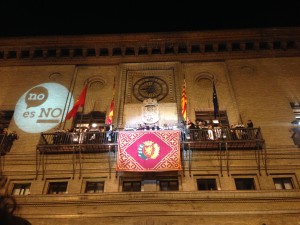
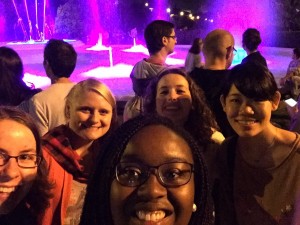

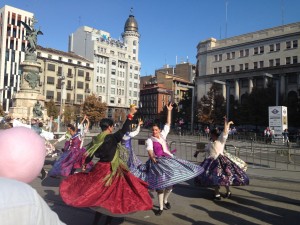
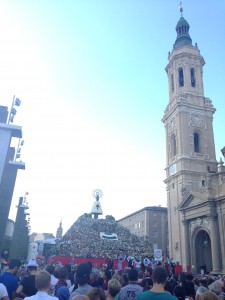
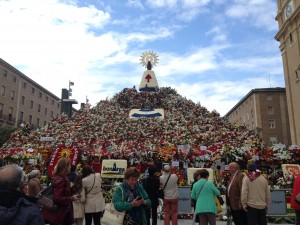
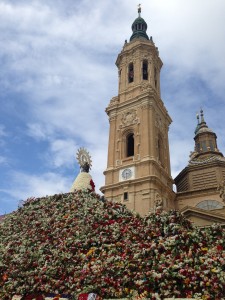

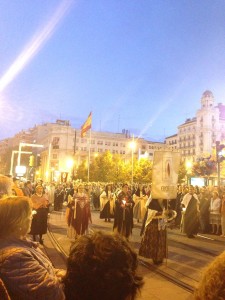
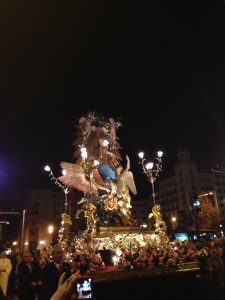
Leave a Reply